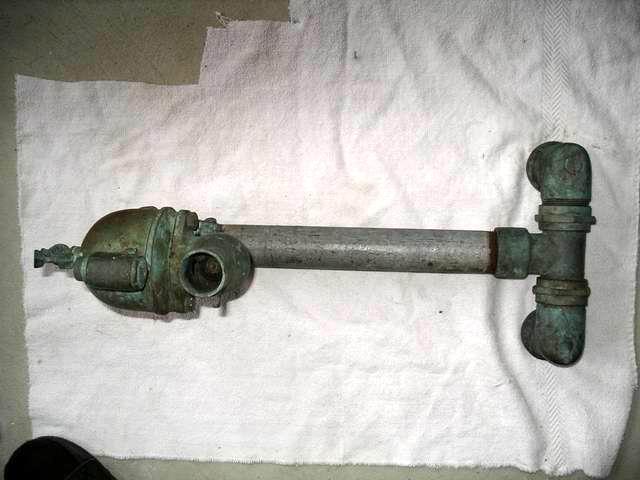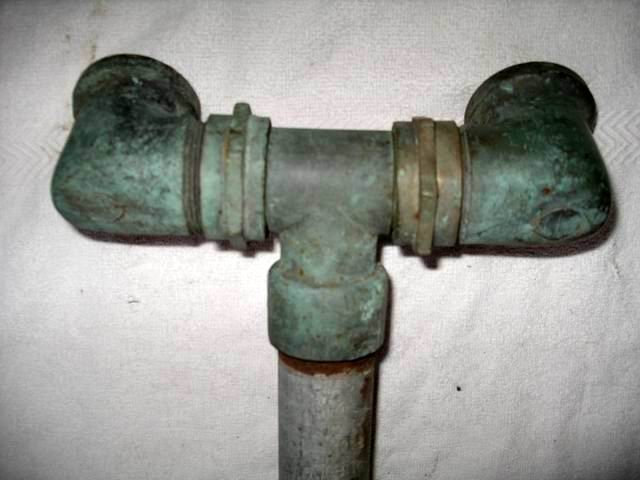| Author |
Message |
    
searcher
Advanced Member
Username: searcher
Post Number: 39
Registered: 10-2004
| | Posted on Thursday, June 02, 2005 - 10:00 pm: | 




|
The fellow who gave me this piece a few months ago had no idea what it came off. The Schebler D carburetor and lack of a check valve indicates the arrangement probably was the intake manifold for a 2 cylinder 4 cycle engine. Each of the brass/bronze elbows has a groove inside it. There is a fiber packing in the groove. When the hex nuts are taken up, the fiber packing makes a tight, but probably somewhat flexible joint. The ends that would connect to the engine are not threaded. Rather, it would appear that they slid on over a mating part on the engine and were then bound tightly to the engine by some type of clamping arrangement. The only markings on these fittings is "17?". It could be 171 and 172 or 17L and 17R. The lettering is rather crude and not well defined in the casting.
Is this a widely used type of manfold or was it specific to one engine manufacturer?
 |
    
searcher
Advanced Member
Username: searcher
Post Number: 40
Registered: 10-2004
| | Posted on Thursday, June 02, 2005 - 10:03 pm: | 




|
 |
    
searcher
Senior Member
Username: searcher
Post Number: 74
Registered: 10-2004
| | Posted on Thursday, December 29, 2005 - 08:40 pm: | 




|
I recently stumbled onto the answer to my own question. Page 8 of the 1907 Palmer Brothers Catalog reprinted by Richard Day illustrates the Palmer L2 and M2 four cycle motor. This is a dead ringer for the Palmer arrangement on those motors. Now, I think I better go back and see if the other end of this is hiding out somewhere back of the fellow's barn. |
    
richardday
Senior Member
Username: richardday
Post Number: 513
Registered: 11-2003

| | Posted on Friday, December 30, 2005 - 08:51 am: | 




|
I agree it is a Palmer L-2 intake manifold. Eric Johansen up in Alaska is trying to restore an L-2 and he needs this item I am sure. The model D and and the galvanized pipe section probably were used in some other application as I don't think it would work vertically on the L-2. Classic Palmer practice would be for the L-4 to have two similar top portions with brass nipples to a T between number 2 and 3 cylinder with a brass nipple down to the Model D. The T would angle down to compensate for the angle out of the upper Ts. The length of the nipples from the upper Ts would be picked to allow clearance out from the side of the engine.
I have at least one intake manifold made up for the Model NR or ZR which is made up as I describe above except in that case the flange connecting to the cylinder is at 90 degrees to the nipple extended down to a 90 degree elbow with a nipple to the T down to the Model D. In this one it is all black iron. The watermen didn't bother with niceties of brass pipe if they could avoid it. Nice find. Now find the engine that goes with it. |
    
searcher
Senior Member
Username: searcher
Post Number: 75
Registered: 10-2004
| | Posted on Friday, December 30, 2005 - 11:37 am: | 




|
Thanks for responding. My comment on going back to find the engine was wishful thinking. The fellow who gave me the manifold said it had been
lying around back of his barn for several decades and that he had absolutely no idea
where it came from or what it went to. |
    
searcher
Senior Member
Username: searcher
Post Number: 77
Registered: 10-2004
| | Posted on Sunday, January 08, 2006 - 04:39 pm: | 




|
Richard,
As to your note regarding Eric Johansen restoring a Palmer L-2, I am not inclined to sell the manifold but I would trade it up or down for a brass injector/fuel feeder that went on the Detroit Marine, Detroit Auto Car Supply, Columbia, Termatt and Monahan, Sandow, et al, family of single cylinder marine engines. |


